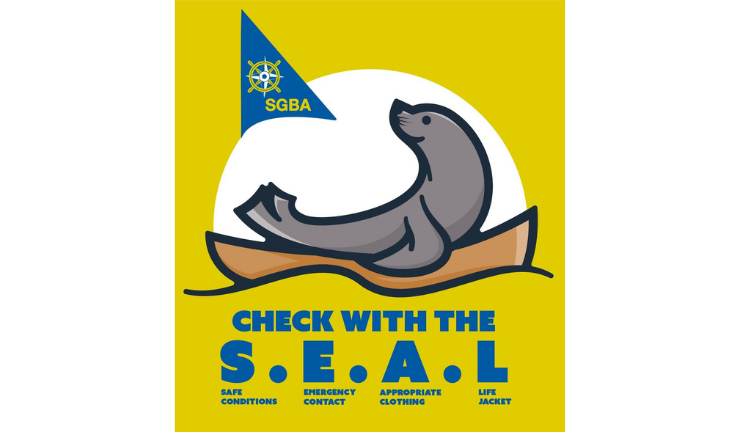Stay safe and check with the SEAL

A barking seal helped to avoid serious consequences following an incident near the SGBA base at Mill Point, on the Dart Estuary, in May 2021, and led to a remarkable safety campaign.
Roger Stobbart, a committee member at Stoke Gabriel Boating Association (SGBA) working on his boat, but below deck, was alerted by a barking seal to the crew in the water and separated from a RS Quest dinghy which had capsized. There were no other craft on the river. Having rescued the crew (who was cold but unharmed), he assisted the helm to recover the Quest back to shore.
Although the helm had both RYA Level 1 and 2 qualifications and a Day Skipper certificate, he was relatively inexperienced in terms of local knowledge and weather conditions, and not familiar with the Quest. His crew was a novice. While both were wearing buoyancy aids, they did not have wetsuits, had left mobile phones in the clubhouse, and had not arranged buddy cover. The seal’s behaviour was crucial to their safe rescue. There was no organised sailing activity that day.
Peter Waite, RYA Principal at the club, conducted a full accident investigation and concluded that while lack of familiarity with the dinghy and the estuary were the immediate cause, the sailors’ lack of local knowledge and not having any means to summon assistance were contributors to the situation which could have been much more serious. SGBA is dedicated to providing safe opportunities for getting afloat but is unwilling to place any restrictions on members’ access to the Dart Estuary, which is open for anyone to go afloat.
It was at this point that Louise Ross, the club’s Safeguarding/Welfare Officer, came up with the idea of using the word SEAL as an acronym to emphasise safety advice to members:
1 Safe conditions. Wind and weather can change quickly, and tide will have a big impact on your boating. Check and understand both the weather forecast and tide conditions immediately before you set out and that they are within your ability to handle. If the conditions change, be prepared to change your plans.
2 Emergency contact. It is essential you carry an effective means to call for help; ideally a mobile phone in a waterproof case designed so you can operate it in the water. If you are out without a safety boat, then boat with a buddy, have someone on shore keeping an eye or someone who knows your plans. (NB The RYA SafeTrx app monitors your boat journeys and can alert emergency contacts should you fail to arrive on time. It is an app for both Android and Apple iOS smartphones that allows you to track your journey on your phone. https://www.rya.org.uk/knowledge/safety/keep-in-touch/safetrx)
3 Appropriate clothing. Best dress for a capsize. Our waters are cold, so you need a wetsuit or drysuit. Suitable footwear to protect against sharp rocks and oyster shells is essential.
4 Life jacket or buoyancy aid. Correctly sized and fitted properly, these are essential for your safety and survival in an emergency. It is a requirement that you provide your own for use on all SGBA craft and activities on the water.
Louise also suggested using a seal graphic to bring further attention to the safety advice. This was produced by Kirsty and Jason of the River Dart Gallery and now SGBA has used the design and wording on its website, on flyers and on stickers that have been attached to all club boats.

Although the design is copyrighted to SGBA, they would like to share the message widely, and are offering the design artwork to other sailing clubs (some of whom may already be aware of the amazing behaviour of seals), for non-commercial use.
The club is also planning to improve its induction to all new members this year, particularly with regard to the tide, wind and weather issues specific to the area.
